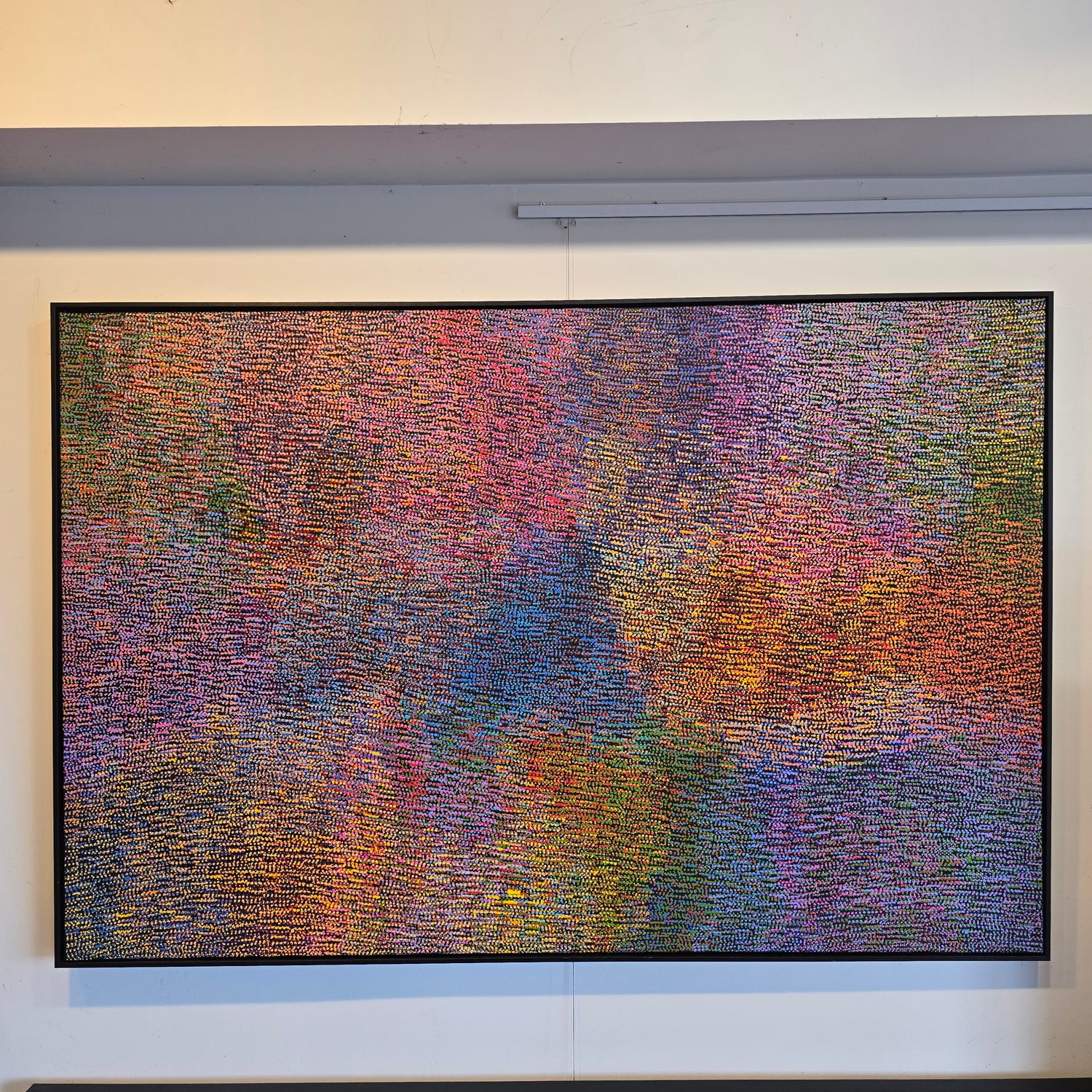Collection: Michelle Cooper
-
Michelle Cooper 970 mm x 1500 mm
CODE : 9596Vendor:Michele cooperRegular price $4,500.00 AUDRegular priceUnit price / per -
 Sold out
Sold outMichelle Cooper 1200 mm x 1800 mm
CODE : 8643Vendor:Michele cooperRegular price $5,500.00 AUDRegular priceUnit price / per
Australian Indigenous artist, Michelle Cooper demonstrates a revered position among Pitjantjatjara artists because her complex artwork reveals the fundamental elements of Tjukurpa (Dreaming stories). Through her role as cultural guardian she uses traditional skills to produce artistic representations portraying the ceremonial and sacred aspects of the Pitjantjatjara land. Michelle accomplishes this through her precise tiny dot patterns along with a diverse application of colours, which guarantees that her ancestral stories will continue to inspire viewers worldwide.
Early Life and Cultural Heritage
Michelle Cooper was born in 1971 in the Kalka Community which resides on the Anangu Pitjantjatjara Yankunytjatjara (APY) Lands in South Australia. The lands exhibit a spiritual and artistic cultural tradition which has endured for thousands of years.
The development of her artistic career deeply relied on the influence of her family members. When her Warlpiri mother passed away Michelle moved to Alice Springs for her upbringing through the mentorship of her paternal grandmother Kuntjil Cooper (1920–2010). Kuntjil maintained a respected position as both a Pitjantjatjara artist and storyteller who taught Michelle the Women's Dreaming stories that are sacred to her people. As central elements of Pitjantjatjara heritage, the ancestral stories outline ancestral movements throughout the lands as well as their instructive encounters and sacred rituals.
Through her childhood, Michelle diligently learned every intricate detail of these stories and ultimately created her artwork by following in the footsteps of her female ancestors. The practice of creating art in her tradition flows from current and ancestral storytelling practices to safeguard essential tribal wisdom for upcoming generations.
Artistic Journey and Unique Style
Michelle Cooper's art is deeply symbolic and spiritual, grounded in the landscapes, rituals, and ceremonies of the APY Lands. Her works are often inspired by:
Collapsible content
The Seven Sisters Dreaming (Kungkarangkalpa)
The Seven Sisters Dreaming is a sacred story about ancestral women fleeing a male pursuer, forming key landmarks in the desert.
Women's Ceremony Stories
Representations of important rites of passage, songlines, and sacred women's business.
Walka Wiru Ngura Wiru (Lovely Country, Lovely Painting)
A signature series that reflects the landscapes and terrain of the Tompkinson Ranges, which includes the Pipalyatjara, Kalka, and Irrunytju communities.
The core aspect of her paintings is her unique dot work technique which generates multiple effects representing desert night atmospheres together with ceremonial locations and moving dunes in Australia's outback. The depiction in her artwork diverges from Western artistic convention since it relies on a topographical map-like perspective which Indigenous Australians have practiced using for tens of thousands of years.
Michelle's colour selection depends on the theme she is painting. Her artwork displays desert terrain elements by utilizing reddish brown ochres and yellow tones to represent her native Australian lands. The artists use cool tones comprising blues, purples, and whites to symbolize night sky elements, ancestral spiritual presence, and celestial bodies.
The paintings reveal both artistic beauty and cultural directions which lead visitors into the vital territories and wisdom of the Pitjantjatjara people.
Recognition and Exhibitions
The artistic abilities of Michelle Cooper have received recognition from various locations throughout Australia and beyond its borders. Her artwork appears in prominent exhibition spaces along with major collections because viewers recognize her intricate work as spiritually deep with cultural weight. Michelle’s paintings have been displayed in:
-
1. National Museum of Australia
-
2. South Australian Museum
-
3. Art Gallery of South Australia
-
4. Indigenous art collections across Europe and North America
Her works have been acquired by both public and private collectors who appreciate the depth of Indigenous storytelling embedded within her art.

Connection to Community and Family
The growing fame of Michelle has not made her distance herself from her community or family ties. She stays active in both Alice Springs and Kalka Community while seeking to maintain cultural traditions which serve as her artistic inspiration.
Michelle uses her paintings to support both the cultural and economic growth of her people while sustaining the strong essence of Pitjantjatjara cultural traditions. She actively defends ethical art practices while collaborating with established Indigenous-owned art centres which defend the artistic rights of Aboriginal artists and secure proper payment for their artwork.
Legacy and Lasting Impact
Michelle Cooper functions as both a visual artist and a storyteller combined with cultural preservation duties and Pitjantjatjara cultural ambassadorship. The paintings she creates maintain traditional Aboriginal heritage while adapting it to modern art practices.
The importance of her artistic efforts grows increasingly critical because modern society is recognizing Indigenous knowledge systems for their ecological importance and historical value. Her artistic practice creates a journey that lets people feel the strong bond which ties Pitjantjatjara people to their land and enables society to value the world’s longest-uninterrupted Indigenous culture.
The paintings created by Michelle serve as both visual masterpieces and cultural documents which preserve the ideas of Country, Dreaming and community essence.
Preserving Michelle Cooper's Art with Mandel
Michelle Cooper stands as a significant figure in contemporary Indigenous Australian art, using her talents to preserve, share, and celebrate Pitjantjatjara traditions. Her ability to transform sacred narratives into stunning visual compositions makes her work both culturally profound and aesthetically captivating.
Visit Mandel Aboriginal Art Gallery or check out our website to see Michelle’s masterpieces. As she continues to paint, teach, and inspire, Michelle Cooper remains a powerful voice in Indigenous Australian art.



